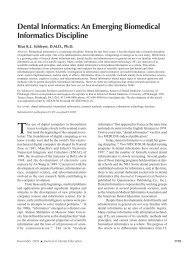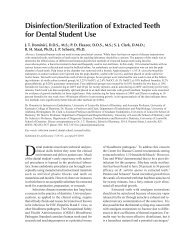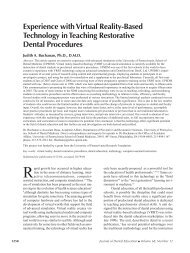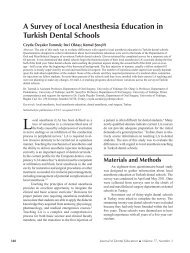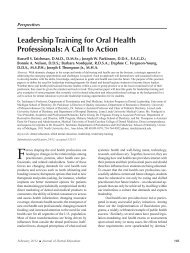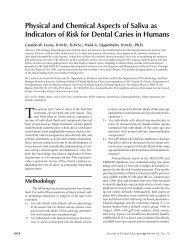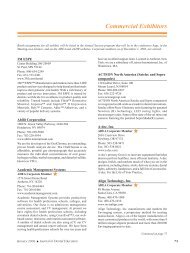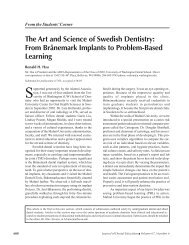List of Poster Presentations - Journal of Dental Education
List of Poster Presentations - Journal of Dental Education
List of Poster Presentations - Journal of Dental Education
Create successful ePaper yourself
Turn your PDF publications into a flip-book with our unique Google optimized e-Paper software.
<strong>Poster</strong> Abstracts<br />
121. Fewer Appeals <strong>of</strong> Preclinical Operative Amalgam<br />
Preparation Practical Evaluations When Two Faculty<br />
Evaluate Each Preparation<br />
Dower, James S., University <strong>of</strong> the Pacific School <strong>of</strong> Dentistry, Kenyon,<br />
Brian J., University <strong>of</strong> the Pacific School <strong>of</strong> Dentistry, Louie, Kenneth<br />
G., University <strong>of</strong> the Pacific School <strong>of</strong> Dentistry<br />
Purpose: Decrease appeals <strong>of</strong> practical evaluations by increasing<br />
student confidence in faculty evaluations and improving faculty<br />
calibration.<br />
Our preclinical operative dentistry course allows students to<br />
appeal the evaluation <strong>of</strong> their practical examinations on amalgam<br />
preparations. Previously one faculty member evaluated the practical<br />
by scoring the student’s handling <strong>of</strong> 22 criteria and initialed the form<br />
so that the student and course director knew who did the evaluation.<br />
If the student disagreed with the evaluation given they had an<br />
opportunity to appeal the evaluation and have it reevaluated by three<br />
instructors with the average <strong>of</strong> the new evaluations becoming the<br />
“final evaluation”. Feeling there was too large a number <strong>of</strong> evaluations<br />
being appealed, the following year we had two faculty members<br />
independently review the preparations, come to an agreement on the<br />
evaluation given, and place their initials on the form. It was hoped<br />
this would increase student confidence in the faculty evaluations and<br />
improve the calibration <strong>of</strong> faculty doing the evaluations. There were<br />
nine practical examinations each year with eight <strong>of</strong> the practicals on<br />
the same teeth and surfaces. With one instructor evaluating the<br />
preparation there were 177 appeals from 135 students for a ratio <strong>of</strong><br />
1.31 appeals per student. With two instructors evaluating the<br />
preparation there were appeals from 139 students for a ratio <strong>of</strong> 1.18<br />
appeals per student. This represents a 9.5% decrease in the number<br />
<strong>of</strong> appealed preparations. We believe the decreased number <strong>of</strong> appeals<br />
is based on increased student confidence in the accuracy <strong>of</strong> the<br />
evaluations and on the faculty being better calibrated for evaluating<br />
practical preparations. Another measure <strong>of</strong> student preference for<br />
having two evaluators was found on the end <strong>of</strong> course survey where<br />
94% <strong>of</strong> the class recommended the two evaluator system be continued<br />
in the course.<br />
Having more than one faculty member responsible for the<br />
student’s evaluation on amalgam preparations in preclinical operative<br />
dentistry increases the student’s confidence in the accuracy <strong>of</strong> the<br />
evaluation and diminishes the number <strong>of</strong> evaluations appealed.<br />
122. New Technologies in <strong>Dental</strong> <strong>Education</strong>: A Survey <strong>of</strong><br />
Second-year <strong>Dental</strong> Students at Tufts School <strong>of</strong> <strong>Dental</strong><br />
Medicine Concerning the Simulation Clinic Experience<br />
Eisen, Debbie S., Tufts University School <strong>of</strong> <strong>Dental</strong> Medicine, Eisen,<br />
Steven E., Tufts University School <strong>of</strong> <strong>Dental</strong> Medicine<br />
The Simulation Clinic has recently been introduced to help<br />
prepare preclinical students by allowing the student to learn the proper<br />
ergonomic way to practice dentistry. <strong>Dental</strong> educators stress the use<br />
<strong>of</strong> magnification loupes along with posture and seating. In this study,<br />
we sought to assess the usefulness <strong>of</strong> the Simulation Clinic versus<br />
more traditional modalities by surveying dental students concerning<br />
their experiences with both it and the more traditional modalities.<br />
During the spring term <strong>of</strong> 2001, 2nd year dental students at<br />
Tufts University School <strong>of</strong> <strong>Dental</strong> Medicine were surveyed concerning<br />
their experience in the computer-based Simulation Clinic, a<br />
technology for promoting accelerated learning in preclinical students,<br />
in order to better prepare them for their clinical training. Out <strong>of</strong> a<br />
total <strong>of</strong> 145 2nd year students, 55 responded to this survey. 47 (85.5%)<br />
respondents made use <strong>of</strong> the Simulation Clinic during scheduled time,<br />
8 (14.5%) made use <strong>of</strong> the Clinic during both scheduled and non-<br />
scheduled time. 11 (20%) respondents spent about the same amount<br />
<strong>of</strong> time using the Simulation Clinic as they did the Preclinical Lab<br />
Bench Stick, 17 (30.9%) spent more time in the Simulation Clinic,<br />
and 27 (49.1%) spent more time with the Preclinical Lab Bench Stick.<br />
50 (90.9%) respondents thought they learned more from the<br />
Simulation Clinic, while 4 (7.3%) learned more from the Preclinical<br />
Lab Stick. All students would prefer to have spent more time at the<br />
Simulation Clinic. 53 (96.4%) would advise incoming preclinical<br />
students to spend more time in the Simulation Clinic and 2 (3.6%)<br />
would advise spending about the same amount <strong>of</strong> time as they did in<br />
the Clinic. Among students who had actual patient contact at this<br />
time, 38 (69.1%) felt that their training in the Simulation Clinic gave<br />
them increased confidence to work on patients. 15 (27.3%) still did<br />
not feel ready to work on patients. Only 2 (3.6%) did not have patient<br />
contact at this time. 32 (58.2%) respondents thought the addition <strong>of</strong> a<br />
video monitor-screen would greatly improve their temporal-spatial<br />
understanding <strong>of</strong> the task, 1 (1.8%) thought there would be moderate<br />
improvement, and 22 (40%) did not think they would gain any<br />
advantage.<br />
The Simulation Clinic will allow the dental students to accelerate<br />
his/her entrance into treating patients much more easily since they<br />
have been exposed to a realistic patient figure earlier in their dental<br />
training. The Simulation Clinic provides a torso with air/water<br />
capabilities as well as a video monitor screen so that the daily task<br />
can be visualized and performed. New instructional technologies like<br />
the Simulation Clinic accelerate the learning process. These<br />
instructional technologies are preferred by students to the more<br />
traditional modalities, and are starting to replace the more traditional<br />
instructional modalities.<br />
123. Service Learning — More Than a Teaching Model<br />
Forde, Ron, Loma Linda University School <strong>of</strong> Dentistry, Nick, Doyle,<br />
Loma Linda University School <strong>of</strong> Dentistry<br />
Purpose: To highlight other outcomes on dental and dental<br />
hygiene students beyond the strengthening <strong>of</strong> clinical skills.<br />
Loma Linda University School <strong>of</strong> Dentistry (LLUSD) has within<br />
its mission statement, a commitment to service learning. This<br />
commitment has expressed itself almost from the inception <strong>of</strong> LLUSD,<br />
and has continued to grow, as it reaches out to underserved<br />
communities locally, nationally and internationally. The goal <strong>of</strong> this<br />
commitment is to graduate dentists /dental hygienists who understand<br />
that their careers and lives can be enhanced by spending time and<br />
effort in meeting the needs <strong>of</strong> those who face barriers to dental<br />
services. Currently, LLUSD continues to create opportunities for its<br />
students to gain hands-on experiences in various community settings.<br />
Many <strong>of</strong> these opportunities are built into the curriculum. This poster<br />
exhibit will document the opportunities provided for students to serve,<br />
the responses <strong>of</strong> students to these opportunities, and the results <strong>of</strong><br />
their experiences. Also to be presented will be the impact that such<br />
experiences have on the students, beyond the improvement <strong>of</strong> clinical<br />
skills. These results will be based on fourteen local and national sites,<br />
and another fourteen international sites, in which over 5,600 patients<br />
were seen and/or treated in the period <strong>of</strong> June 1, 2000 - May 31,<br />
2001. The results will show that Service Learning opportunities build<br />
student morale (self-confidence), strengthens personal clinical<br />
confidence, helps the new dentists to see dentistry as patient oriented<br />
rather than procedure oriented, makes for a more supportive alumni,<br />
builds bridges between student and faculty, and provide a sense <strong>of</strong><br />
pr<strong>of</strong>essional independence.<br />
Service Learning can be the soul <strong>of</strong> an institution <strong>of</strong> higher<br />
learning, giving direction and purpose to the clinical skills taught to<br />
its students, and affirming the humanity <strong>of</strong> our pr<strong>of</strong>ession.<br />
296 <strong>Journal</strong> <strong>of</strong> <strong>Dental</strong> <strong>Education</strong> ■ Volume 66, No. 2



